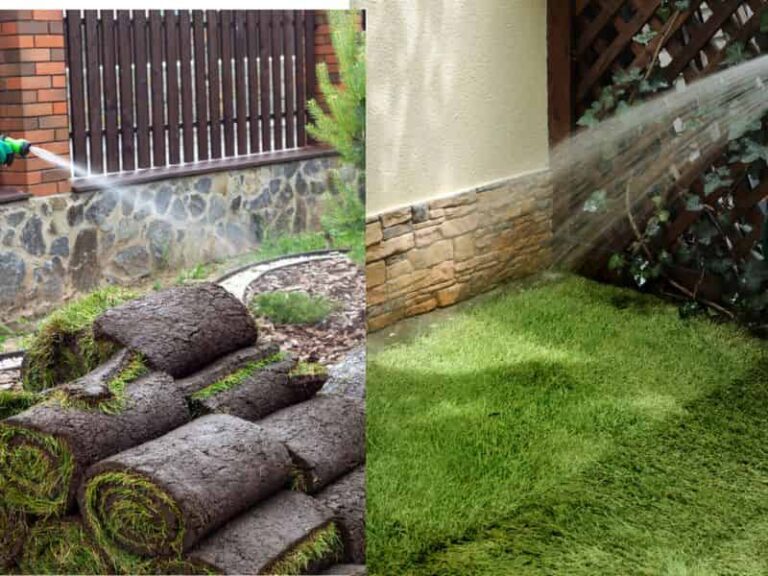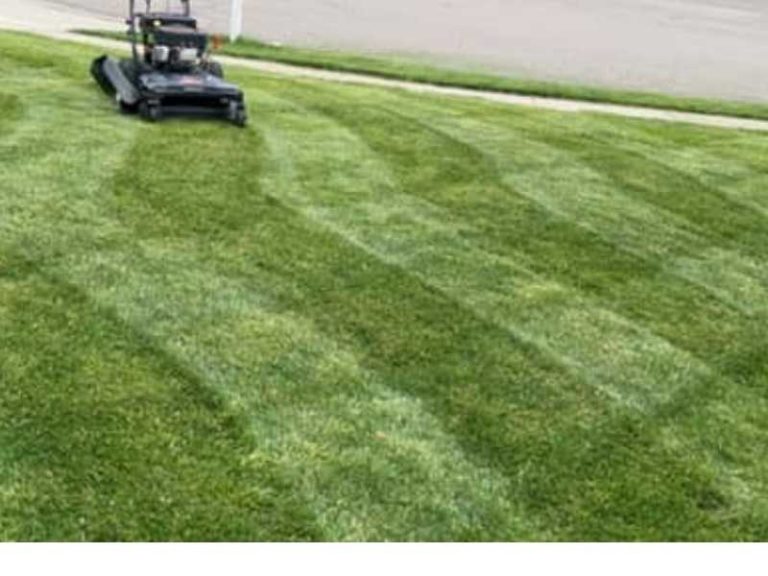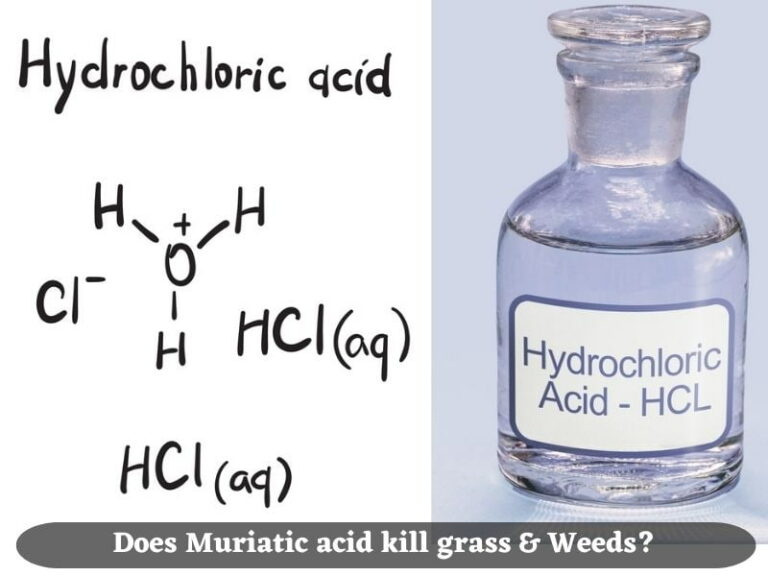How to Improve Clay Soil for Lawns – 5 Fixes for Better Drainage
Clay soil is usually poorly aerated, compacted, and strenuous to the plants and lawn owners. Some grass types, such as tall fescue, grow well in clay soil, but some may struggle due to poor drainage. Most grass types require well-aerated soil to grow faster and healthily. Healthy, well-aerated uncompacted clay soil allows grass to enjoy its unique properties and reach its potential. So, how do you improve and fix clay spoil drainage?
To improve your lawn’s clay soil, mix and till with compost, gypsum, or pine bark. These amendments will help loosen the clay soil structure and improve porosity, aeration, and drainage. Another option is to aerate the lawn with a plug aerator every spring to improve soil aeration. Peat moss and sand worsen clay soil structure.
Be it St. Augustine grass, bermudagrass, or any other grass type; you may want to amend a clay soil yard before laying down your sod or seed. Some simple steps can help aerate the soil, which I will show you.
Table of Contents
How To Know Your Lawn Has Clay Soil?
Clay soils have fine particles that define their structure and texture. This kind of soil aerates poorly and, as such, will hold a lot of water and remain wet and cold throughout winter and dry out in summer.
To test for clay soil in your yard:
- Dig up a sample in your yard and scoop some of it in your hand.
- Add a little water to make it damp.
- Squeeze the sample in your hand and release it.

Clay soil will remain clamped in shape as opposed to loam or silt samples that would crack and break.
This test is a simple DIY one, but to get accurate results, you may want to do a professional soil test to get a comprehensive analysis that may include pH and nutrient levels.
A professional soil test will determine how much silt, clay, sand, and organic material is present in your soil mix to help you determine the right type of grass to plant on your clay soil lawn.
Why is Clay Soil Bad for Your Lawn?
Clay soil is not suitable for growing a healthy lawn since soil particles are heavy and compact easily. The soil holds too much water and can make the lawn soggy or waterlogged, especially if there is excess watering.
Here are the reasons why clay soil is not good for your lawn:
- Compaction: Clay soils have poor drainage and can lead to waterlogging. The grass will turn yellow and start to die if there aren’t breathing spaces in the soil.
- Shallow roots: grassroots suffocate in heavy clay soil and may develop poorly.
- Soggy yard after watering: You might find yourself with a yard that’s always muddy because clay soil does not drain easily if not amended.
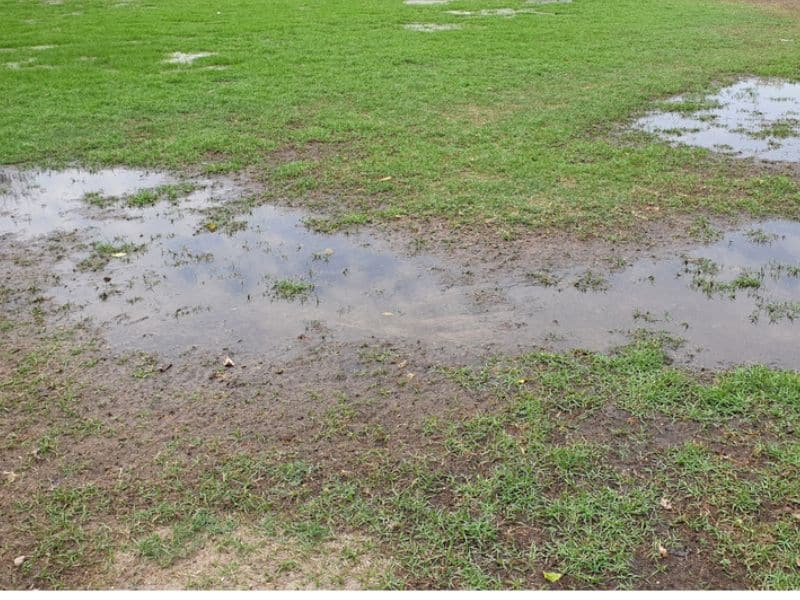
You can successfully establish a lawn on heavy soil, but you will first need to break up the clay soil to improve drainage and aeration.
Tip: Amending clay coupled with its unique properties can make it one of the best soil types for your lawn. It provides a strong foundation for healthy grass growth and has small soil particles that hold up water moisture well. Amendment improves soil micro-organisms processes. Clay requires less fertilization since it holds nutrients well for your lawn needs.
I’ve discussed below the best fixes and ways to improve clay soil and establish a lawn with healthy grass.
How to Improve Clay Soil for Lawns
To break up heavily compacted clay soil in your lawn, you’ll depend on organic material and other practices to improve aeration and drainage. Tilling and using amendments are the best options before establishing a lawn, but there are solutions for breaking up clay soil, even for existing lawns.
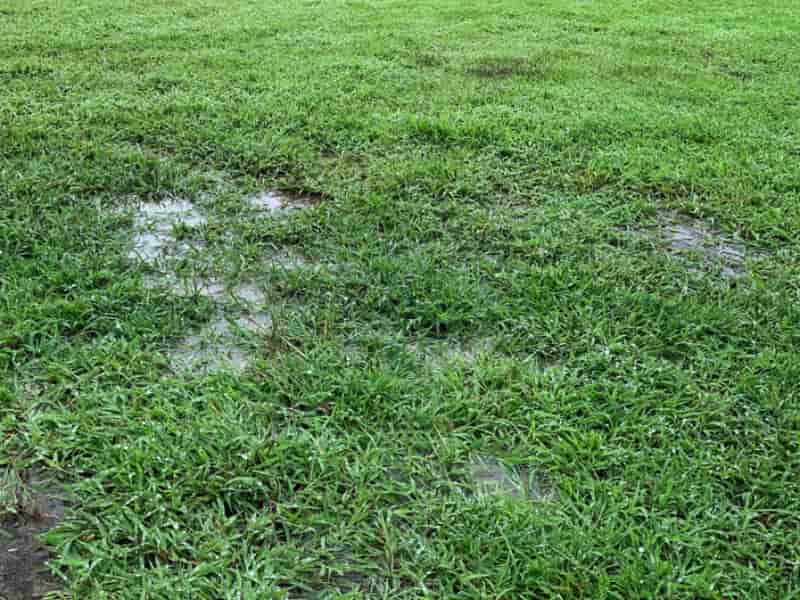
Here’s how to improve clay soil for lawns and fix its drainage:
Till and break up clay with manure
Clay soil can be hard to till, especially when dry. You’ll need to soften it with water to make it damp and moist. Spread 2 inches of manure on top of the clay soil and till it in to mix properly. This will help improve the drainage and texture of the soil.
Pro tip: Try not to till clay soil when wet or dry. Too much water will create a mud paddle while tilling, and when dry will create too much dust in your yard. Fine dust can worsen clay soil because it easily holds too much water.
Add gypsum to the clay soil
Gypsum is naturally occurring calcium sulfate that you can use to break up heavily compacted clay soil on your lawn. When added to the soil, gypsum improves the texture by making the fine particles come together to make larger particles with improved drainage and aeration.
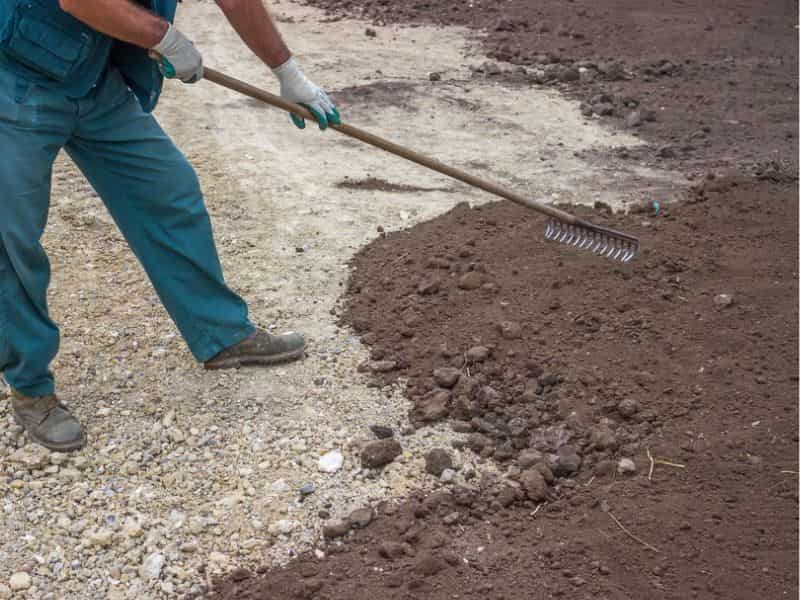
To improve clay soil using gypsum, apply 1 kilogram of gypsum per square meter of your yard and dig it well into the top 15 centimeters. Mix it well so that the soluble calcium can enhance the porosity and aggregation of the clay soils and improve air and water infiltration.
Pro tip: Clay soils are highly nutritious. If you opt to use gypsum to improve the soil for your lawn, avoid applying too much of it. Too much gypsum can eliminate essential nutrients, including aluminum, manganese, and iron.
Add compost
One of the best ways to improve the drainage in a clay soil lawn is by adding compost. Rotted leaves and manure are a great amendment you can add to your yard with clay soil to improve it.
Before planting new grass, add about 1-3 inches of compost onto the clay soil and till it in thoroughly to improve the texture and porosity. The organic matter in the composted leaves will also attract worms and other microorganisms that improve the fertility of the soil on your lawn.
As the organic matter is broken down, it builds the soil’s tilth by coating the soil particles to separate them and improve aggregation. Aggregated soil is much better at reducing crusting, improving water infiltration, and reducing erosion in your lawn.
Amend clay soil with humic acid
Humic acid is one of the highly recommended amendments for compacted clay soils in any yard. But how does it work? It generates and activates microbial activity that helps restructure compacted soil.
You should, however, not expect humic acid to break down clay soil that is heavily compacted. For this problem, you may want to use other organic methods, such as tilling and adding compost to the soil.
Other great clay soil amendments similar to humic acid include Aerify Plus Liquid Soil Aerator and Soil Conditioner, which can help break down compacted clay soil on the lawn.
Aerate the lawn
It might be time to aerate if your lawn is too compacted because of being established on clay soil. Lawn aeration is the process of perforating the soil by removing plugs of soil to allow air (oxygen), water, and nutrients to penetrate for easy access by the grassroots.
You can aerate your lawn using a spike aerator or plug aerator. The tines of your aerator will poke holes or remove the plugs of soil and thatch to create the needed spaces for improved aeration of clay soil.
Pro tip: Plug or core aeration is the best way to improve the core of clay soil as opposed to spike aeration, especially for deeply compacted soil. The results will last longer because the spaces are much bigger than those of spike aeration – which are usually small from the soil being pushed sideways.
Topdress with sand
Topdressing lawns with sand can help improve compaction in clay soils, but it is not the best fix for the problem. In fact, I wouldn’t recommend this option unless it is the only one you have available.
If you must, add a little sand to help loosen the soil and open it up for better aeration. It will be an option to grow grass types that grow in sandy soils. Keep in mind that this will not improve the soil structure of clay soils. Instead, opt for more organic solutions such as compost, pine bark, etc.
According to Oregon State University, “No amount of sand can be added to clay soil to change its texture. The large sand particles provide a surface on which the tiny clay particles adhere. The result can be a more difficult soil to manage….”
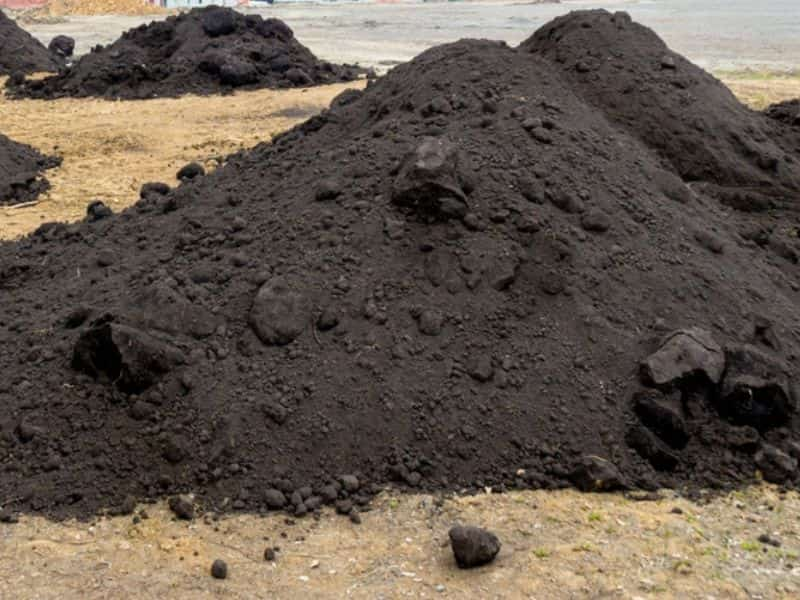
Can You Amend the Clay Soil in Existing Lawns?
The method of adding compost, gypsum, and pine bark can help amend clay soil before establishing a lawn, but you might want to use other options to break down and loosen clay soil in an existing lawn.
The best way to amend clay soil in an existing lawn is by aerating and dethatching. A plug aerator can remove plugs of soil to loosen up the soil and create spaces for air, water, and nutrient penetration in the soil.
Allowing thatch build-up on a lawn with clay soil can worsen the layer of dead matter and can worsen compaction and aeration problems. Therefore, dethatching is a great way to help grass thrive well on lawns built on clay soils.
What Grass Grows in Clay Soil?
If breaking up clay soil is not a working solution, you may want to think and opt for a turfgrass that grows in clay soil. Zoysia, buffalo grass, tall fescue, and Bermuda grass are great grass types to grow on clayey turfs, depending on the region’s climate.
To help your grass survive and thrive in clay soils, it is important to ensure a deep, extensive root system to absorb nutrients and water in poorly aerated soils.
Read More: Best Grasses for Clay Soil.
Here is a video guide on how to break clay soil fast.
FAQs
What do you add to clay soil to make it better?
The best amendments for clay soil should help improve and enhance its structure, drainage, aeration, and nutrient content. You can add organic matter, compost and aged manure, gypsum, perlite or vermiculite, rice hulls, haydite, lime, sand, and mulch and carefully you can lightly add peat moss.
Use a garden fork, tiller, or any other tools to incorporate the amendments into clay soil. Regular amendment of the clay soil with time will improve the soil structure and fertility.
How do you break down clay soil fast?
https://youtu.be/xurKyzbiMVw?t=177
Does ClayMend really work?
ClayMend is a blend of naturally occurring organic acids and soil microbes with a little nitrogen and sulfur. According to humic green, this liquid soil amendment works by changing and improving the clay soil structure and enhances its ability to create and store nutrients needed by turf grass for healthier growth.
Clay Mend introduces beneficial soil microbes and supplies them with nutrients and gathers the ultra-fine soil particles to work together to support plant growth.
The process allows the soil to breathe which in turn increases beneficial microbial activity allowing the grassroots to establish in the restructured clay soil.
What is the weakness of clay soil?
The main problem with clay soil is its dense structure that restricts nutrients and locks up inhibiting plant roots’ access to these nutrients that are in the soil. This is generally caused by its physical clay soil makeup and its nutrient composition; dispersed microscopic particles, animal waste, water moisture, and excess salt and sodium from the environment.
Compact clay soil structure causes other issues like; poor airflow, limits water reaching plant roots, soggy lawns, fungus due to poor drainage, restricts microbes activities, high alkalinity, inhibits plants roots penetration suppressing its development, restricted macro organism activities and nitrate runoff into downstream water.
What is the best material to break up clay soil?
The best materials to add are organic matter that helps to alter clay soil’s physical properties to improve its drainage and aeration, plus enhances microbial and microorganism activities for improved soil health. You can add organic matter, compost, aged manure, gypsum, perlite/ vermiculite, rice hulls, haydite, lime, sand, and mulch to make it better and improve clay soil for lawns.
Reference

